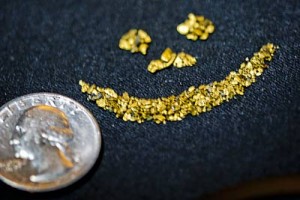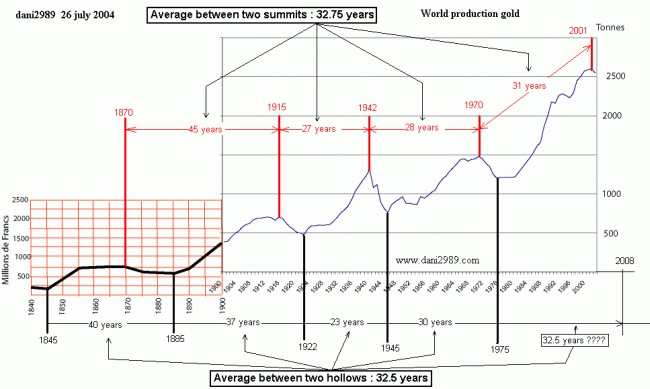I’ve actually had people ask me:
“Is there really any Gold left after the Gold rush of 1849?”
Wow! Yes, there is a lot more gold left!
Perhaps as much as 80% still remains, yet to be found by people like you.
Imagine the amazing adventures you’ll have hunting for and finding native gold…

In fact far more gold is being mined today than a century ago. It’s not usually just sitting there like it was for Mr Marshall at Sutter’s mill, but a big rain storm will introduce and concentrate new gold pay-streaks for you to find
Let’s take a look at Gold production over the last century or more. (See Gold production graph below)
This graph shows several things about world gold production. First it has periodic cycles about every 33 years between max gold production peaks and a moderate (21%) decline for about 7 years. Then it continues to climb decade after decade, so obviously there’s still a lot more gold out there being discovered year after year.
 Notice that the volume of Gold being recovered never declines more than about 21% below the previous maximum. Also, keep in mind for the prospector that gold prices will follow supply & demand effects based on demand and gold production.
Notice that the volume of Gold being recovered never declines more than about 21% below the previous maximum. Also, keep in mind for the prospector that gold prices will follow supply & demand effects based on demand and gold production.
So, we can expect to see prices climb after a peak in production is reached (eg. Latest world annual peak of ~2600 tons about 2001.)
Take all this with a grain of salt (price wise) since world economies & debts play a big role in pricing too.
Let me know what you think in the comments below.
Is there a chance there is any gold in okla and where might I look for it?
what’s faster then panning small gold out of blank sand? like rotating wheel with center cup looking for speed volume
I just want to know is it possible to still find good gold areas? I mean it sounds like an adventure. I just don’t want one where it’s a failure from the start.
Yes it is possible to find good gold areas. It takes a bit of understanding and some practice. A lot depends on your willingness to learn the art and skill of finding gold. Good gold isn’t found everywhere, so you need to be willing to go where it is and often get permission to access it.
I live about 15 miles from Sutter Creek,Ca. in Burson,Ca and have a full force running Creek seasonal into Lake Camanche,is there a possible there is gold in in or minimal amounts that would be worth searching for ?thanks Dan
I live in PR, love looking for gold, I have oll the pans and a lot of inventions for river serch, but I dont know what does the gold im looking for looks like…Unfortunately. .can some one help, I have
look to your videos and see big pices of yellow focks and smoll yellowish flakes but not here, only in videos…
deves buscar en areas donde se minaba el oro en muchos anos atras,tambien buscar el mapa de los minerales en PR ,deves buscar los videos de jess que te ensenan lo que las piedras te dicen por su color y los minerales que estan con el oro,asi puedes conseguirlo mas facil! buena suerte, yo soy nueva en esto, pero veo muchos videos para aprender!
Hi Jess.
I have been told by several people that they have found gold flakes in the steams in the hills in central Illinois. But the maps (USGS MRDS ) don’t show any gold being discovered in Illinois. There is plenty of black sand in this area. Does black sand always mean there is gold?
Black sand means a potential for gold exists, in many cases in the mid west glaciers pulverized gold into ultra fine dust and spread it wide. There are still gravel mines that have gold at bedrock. Not all mines end up on USGS MRDS, just a lot of them, especially is they were in a significant gold production area.
Good AM Jess I am a beginner prospector. I am Quite lucky to start with. My Girlfriend loves to explore and
is very curious about anything to do with minerals, gems,indian artifacts and anything that is petrified.
I have been studying minerals and geology. I am trying to better prepare myself to become an effective prospector. So far I am an explorer , trying out ideas YOU HAVE SUGGESTED and some of my own. I build my own recovery equipment and its fun. I live in San Pedro, Ca. My girlfriend and I dont have to go far to reach desert or mountain regions. We both really enjoy finding and seeing new things in the desert. Can YOU suggest some places that we could search for gold if we have 2 or 3 days to deticate to a specific trip. I know there are many other recorces for me to look in to but both Teresa and I , even though we havn’t met , like you and your approach to finding gold. We liketo use BLM maps with some help . Can You help us?
The problem isn’t finding gold .It is getting the gold out of sulfides in carbonate. Finding someone that is set up to ship a million tons of dirt high in sulfide carbonate gold for processing and still make a profit. I am in Utah and have just that problem. I need someone that uses cyanide , thiosulfate, or floatation to extract 62-91 grams gold per ton. The area is sensitive and we can not leave any tailings or use the local water supply. BLM is very hard to deal with. So the smaller the foot-print the better. No crushing involved just screen and ship. Any ideas? JackWayne
Sounds like a fairly complex question. The ore is rich, but is it rich enough to cover the regulatory processing costs? That’s a tricky one. Which section of Utah roughly?
Jess, how do you extract gold from within a very large quartz vein?
It depends on the type of gold. Large gold crystal bearing specimens bring even larger prices to collectors. Very fine gold in matrix usually requires crushing and processing to reduce the gold out. Borax may be used depending on the quantity of gold and size of particles. Avoid mercury, too many problems with its usage and regulation.
Helloooo P
First time posting. So hopefully this won’t be too silly a question.
The question is. When you go to a wash in gold fields. Do you start in the islands first, if there aren’t any bends?
I’m going out this weekend near Stanton AZ. I’ve got a spot that continuously produces fines and a couple pickers. So I’m always looking for other spots. You know about keeping all your eggs in a basket. So back to islands. I’d assume you’d start on downward point and work up into the island. Much like working the bend in the river. Or do we not start on island? Are/were these islands deposits or eroded away dirt mounds? Would we look for dirt and cobble islands? Or the sandy type?
It’d be nice to know if one or the other are better to start prospecting?
The other question is, what do you look for on straight flowing washes, especially if not many boulders or trees/brush? This is all going by look. Do we look/detect for those black sand deposits?
PS: newly joined H4G and always looking for more education from a knowledgeable mentor. Thanks PJ for helping me/us learn to make us better/successful prospectors.
The key to desert wash prospecting is to know that water is still the prime mover in monsoon flash flood season. So, look carefully for direction changes, narrowing and widening of stream beds (widening slows flow and drops gold.)
Hi there Prospector Jess.., do you travel to anywhere in the US to give hands-on gold prospecting training or give advice to suction dredgers during the suction dredging season.
Thanks,
Ken Takak
Elim, Alaska
That sounds like an interesting proposal. How many do you think would be interested?
I have gone out a few times to find gold, Took me about 8 or 9 time’s before I found some, it was just a few flakes, I was so happy to finally find this first piece of gold. I will be going out again but now with your help I should find more gold this time. I got the Fever thanks Jess.
Gary, I very much enjoy your articles…. A question, why has no gold been found in Arkansas??
I find a total of 4 gold locations in Arkansas in the USGS MRDS records. Not very many. Often this is due to a lack of volcanic hydrothermal activity nearby or a combination of very old mountains too.
Hi Jess I have a question about desert gold. I have been watching videos from Australia and the gold nuggets laying around on the open plains. These plains are huge so how did the gold get way out there? Also Could we compare our own open desert lands the same way? I am in Washington state and have been doing some research on the Columbia basin and these huge dry ancient river beds such as the Moses coulee. Also during the great flood from a glacier dam break thousands of years ago removed approximately 200 feet of top soil from the land. My question is during this massive water flow that carved the Columbia basin would the gold have settled out in the low spots that were formed.
Gary,
The critical vocabulary phrase for desert gold is “alluvial deposit” these are the material deposits brought down from the erosion of massive mountain chains onto the very shallow plains of the desert floor. People often mistakenly think that the majority of desert structure formation takes place through wind as an agent. This is just not true, the big mover in the desert is the same big mover as in the mountains, Water!
As you have noted a massive flood tens of thousands of years ago can leave such a drastic change that we still see evidence of it today. This is the kind of change that moves gold and deposits and re-deposits the placers wherever it will.
It sounds like a good idea for another video, thanks for the question.
Thanks Jess, alluvial deposits and water or where there was water will be my guide. I will keep poking around out there in the open dry river beds and see what I can find. Any insight or added information on this kind of search would be very helpful.